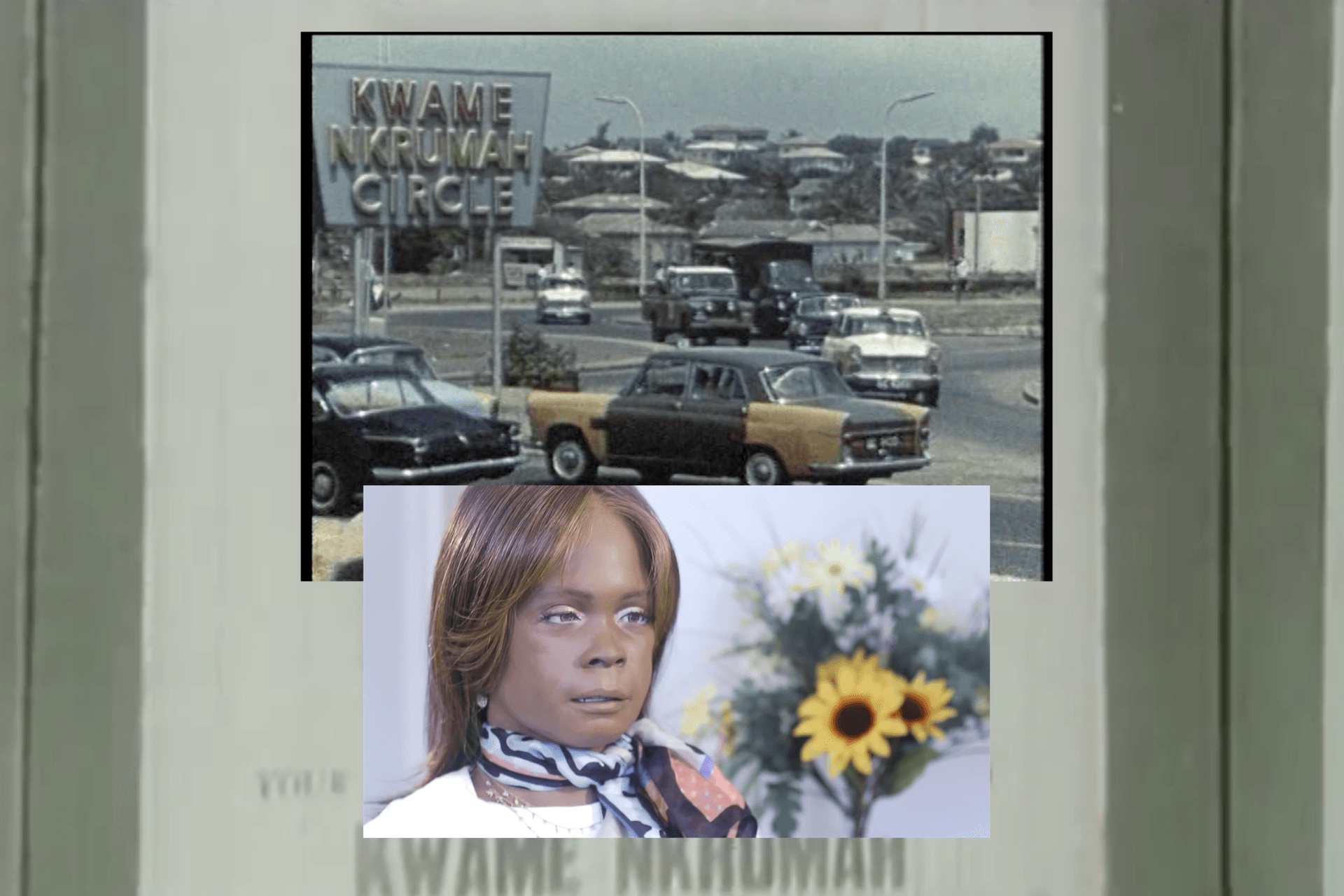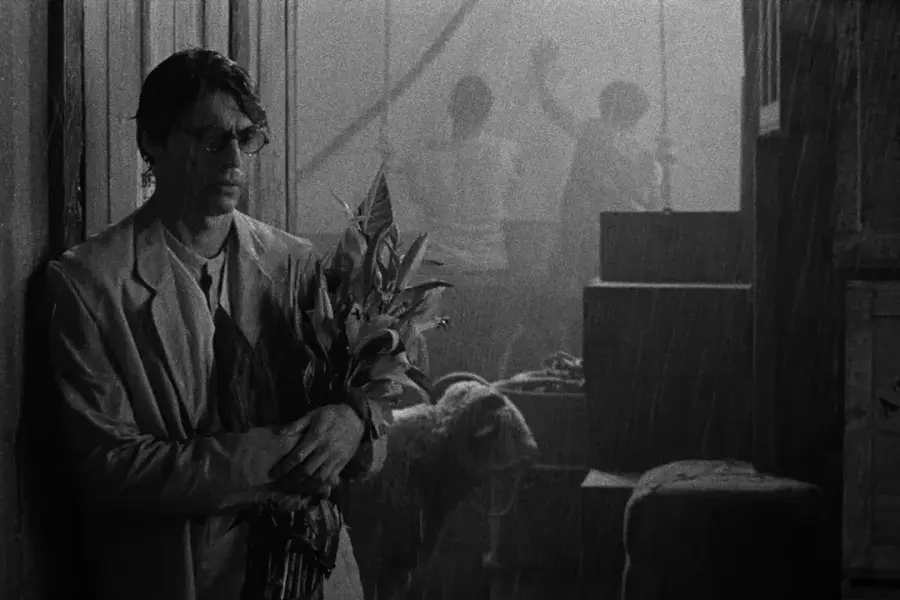The Otolith Group
22.09.24 – 29.09.24

Kunstnernes Hus is pleased to present a new edition of our screening series Silver Series featuring The Otolith Group, an award-winning British artist collective consisting of Anjalika Sagar and Kodwo Eshun. Their work explores the critical potential of images in contemporary society, with a particular focus on utopian histories, speculative fiction, and post-colonialism.
About the films
Be Silent, For The Ears Of God Are Everywhere (2006)
Be Silent, For The Ears Of God Are Eveywhere | The Otolith Group | UK, 2006 | 11:37 minutes
"Commissioned by Fundacion Biacs for the 2nd International Biennal of Contemporary Art of Seville, Be Silent for the ears of the God are everywhere explores the demand for a space of safety that exists outside of disagreement. A space of self-institutionalised intimacy and proximity where those who self-identify as virtuous gather together under the sign of the Guru.
From the mid-1960s onwards, until the present, the guru, defined as the figure that founds and incarnates an organisational force of spiritual power, becomes a global phenomenon, initially in the USA then Europe. The mid-1960s then might be seen as an era of Indophilia of a scale previously unseen in the twentieth century.
The modes of participation and gathering that the guru makes possible allows us to characterize this specific collectivity as an alternative cosmopolitanism. As Srinivas Aravamudan argues in Guru English: South Asian Religions in a Cosmpolitan Language (2005), this transnational religious cosmopolitanism functioned by and through a convergence of 'transidiomatic suppleness, rhetorical persuasiveness,translatability, commodifiability, and consumability'.
The commercial spaces of the long-playing record sleeve provide an opening into the dreamscape of spiritualised Indophilia. Hosted upon the sleeves, one might read the messianic visions of the gurus through the images that circulate beyond the boundaries of the nation state. The liner notes, track titles, logo, front and back artwork of the record sleeve thereby provide a means through which, as Paul Gilroy suggests in his essay Wearing your art on your sleeve: Notes towards a diaspora history of black ephemera, 'cultural and aesthetic exchanges between different populations across the diaspora have been constructed'.
Above all, the record sleeve addresses a public; it invites that audience to assess to share in the styles and symbols that constitute its ideas of itself. The music facilitates the circulation of styles an symbols that create an idea of pleasure,an opportunity for belonging and a space of identification; the poetics of the album sleeve constitutes a politics hidden in plain sight."
Adapted from The Otolith Group, Notes towards Indophilia: On Gurus in Subcontingent: The Indian Subcontinent in Contemporary Art, edited by Maria Grazia Luparia and Gail Swerling, Electa and Fondazione Sandretto Re Rebaudengo, 2006, p. 188. Posted first on The Otolith Group's website.
Hydra Decapita (2010)
Hydra Decapita | The Otolith Group | 2010 | 31 min | Commissioned by The Manifesta Foundation for Manifesta 8 and The Otolith Collective.
Hydra Decapita is a colour film shot in High Definition lasting just over thirty-one minutes and shown as a projection. It exists in an edition of five plus one artists’ proof; this copy is number two in the main edition. The film is centred on the work of Detroit-based techno music duo Drexciya. Drexciya, which was active from 1992–2002, consisted of James Stinson and Gerald Donald. In opposition to mainstream musicians of the time, Drexciya rejected the cult of personality and excess that surrounded the techno scene and instead focused on the conceptual and political. Afro-futurist theories were central to their practice and most notably in their album ‘The Quest’ (1997), where it was revealed that Drexciya was a submerged underwater country that was populated by the unborn children of pregnant women who were thrown overboard during the middle passage of slave ships across the Atlantic.
In Hydra Decapita, The Otolith Group used this imagined world as a point of departure to explore notions of globalisation, capitalism and climate change, with particular attention to the relationships between finance, death, abstraction and language. The film focuses on a legal case from 1781 in which a slave ship called The Zong, which was travelling from Jamaica to Liverpool in England, became lost and the captain of the ship decided to murder all 133 slaves on board by throwing them overboard so that he could claim insurance for the loss of cargo. When the case came to trial in 1783, it was in relation to the insurance claim and not the murder of the slaves. In Hydra Decapita this historical moment is related to a wider understanding of how financial capitalism operates. The artists draw a parallel with J.M.W. Turner’s (1775–1851) painting The Slave Ship 1840 (Tate TW0976), in which the artist attempted to depict the atrocity on board The Zong having read about them in Thomas Clarkson’s The History and Abolition of the Slave Trade (1808). An advocate for the abolition of slavery, Turner exhibited the painting during an anti-slavery conference in London with the intention that it would be seen by Prince Albert, who was speaking at the event, thus prompting him to increase British anti-slavery efforts.
Speaking about Hydra Decapita, Otolith Group member Kodwo Eshun explained:
Hydra Decapita is a way of connecting this historical atrocity to the present of financial capitalism via a few other roots. We link the 1781 atrocity to J.M.W. Turner’s painting, The Slave Ship from 1840, which attempts to visualize this atrocity. Then we link that to John Ruskin’s 1843 text from Modern Painters, volume I, in which he talks about Turner’s methodology for painting water, and he refers to this painting. So, you have this constellation of dates, and finally you have the Detroit electro group Drexciya, which from 1992 to 2002 created a series of albums that were set in this underwater kingdom called Drexciya. This kingdom was populated by the children of slaves who had been thrown overboard during the Middle Passage. [In] this science fiction, the female slaves who were thrown overboard did not die but gave birth to children who could breathe underwater. We constructed a relation between these elements. Visually, the film is extremely monochromatic. It’s also based on singing, so you get a film that has a desolate eeriness to it. And all of this is our way of trying to apprehend abstraction. The idea is that financial capitalism works through abstract processes that nonetheless have real effects, which means that our language, aesthetically speaking, has to become as abstract as reality itself. It also relates to the point that I made earlier, about constructing nonlinear relations to the present.
Nucleaus of the Great Union (2018)
Exhibition: Parapolitics: Cultural Freedom and the Cold War. Commissioned by Haus der Kulturen der Welt, Berlin. 3 Nov, 2017 – 8 Jan, 2018.
In the Summer of 1953, Richard Wright, the most renowned African-American novelist in the world, travelled to the African continent for the first time. For ten weeks, Wright travelled throughout the Gold Coast, where he witnessed Kwame Nkrumah’s Convention People’s Party, West Africa’s first mass socialist party, as it campaigned for independence from British rule. In 1954, Wright published Black Power: A Record of Reactions in a Land of Pathos, a text whose conceptual restlessness registered his existential alienation from the Gold Coast and challenged readers expecting a comforting ode to the consolations of racial belonging. Generations of intellectuals have journeyed from the United States to the new nation state of Ghana ever since; each of them compelled to confront the discomforting questions Wright asked of himself.
Despite the critical attention devoted to Black Power: A Record of Reactions in a Land of Pathos, few of its readers realized that Wright shot over 1,500 photographs with his own professional grade camera on his journey throughout the Gold Coast. Wright intended Black Power: A Record of Reactions in a Land of Pathos to be an ambitious photo-text in which images shared equal space with text. Wright’s publishers Harpers refused to publish the book with his carefully selected and captioned images. The negatives and paper prints of this still unseen photographic archive are now housed in the Special Collections at the Beinecke Library in Yale University; several hundred have recently been digitized.
The project provisionally entitled Through the Camera Sight returns to this archive to compose new links between its unseen images and its historical text in order to reconfigure both. By treating Wright as the photographic modernist he was, Black Power: A Record of Reactions in a Land of Pathos is reimagined as an aesthetic of espionage assembled from still images and floating captions. The unease and the disquiet experienced by Wright in Ghana is reciprocated by the distrust and the distance of the CPP’s Pan-African Socialists. In a Global Cold War, the watchful eyes and the sullen stares, the unspoken suspicions and the undeclared affiliation speak of the tension and the trepidation of political transfer from the British empire to the Gold Coast colony to Ghana the postcolony.



